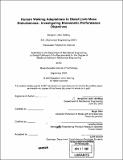| dc.contributor.advisor | Hugh Herr. | en_US |
| dc.contributor.author | Swilling, Benjamin John | en_US |
| dc.contributor.other | Massachusetts Institute of Technology. Dept. of Mechanical Engineering. | en_US |
| dc.date.accessioned | 2006-08-25T18:56:03Z | |
| dc.date.available | 2006-08-25T18:56:03Z | |
| dc.date.copyright | 2005 | en_US |
| dc.date.issued | 2005 | en_US |
| dc.identifier.uri | http://hdl.handle.net/1721.1/33911 | |
| dc.description | Thesis (S.M.)--Massachusetts Institute of Technology, Dept. of Mechanical Engineering, 2005. | en_US |
| dc.description | Includes bibliographical references (leaves 101-103). | en_US |
| dc.description.abstract | Online optimal trajectory planning is required in the control of humanoid robots, advanced prostheses, and impaired human limbs via functional neuromuscular stimulation . Optimization problems that involve complex, high degree of freedom simulations of the musculoskeletal system require extensive computational effort to solve. A methodology for generating optimal gait patterns in an online and computationally efficient manner is needed. It is the goal of this thesis to work towards the development of biologic performance criteria that can be utilized in finding solutions to reduced order walking optimization problems. Toward the development of biologically realistic performance criteria, human subjects were inertially-perturbed and the reorganization of gait quantitatively measured. Ten subjects walked at a self-selected speed with and without a 5 kg mass attached to the right ankle. Kinetic and kinematic data were collected for the weighted and unweighted conditions using ground force platforms and a multi-camera infrared tracking system, respectively. A 16 segment model of the body was built for each subject and a variety of kinematic, kinetic, and total system parameters calculated throughout the gait cycle. | en_US |
| dc.description.abstract | (cont.) Additionally, the normal kinematic dataset was analyzed with a 5 kg mass virtually placed on the right ankle. The virtual mass dataset served as a known suboptimal solution as a basis for comparison. A Wilcoxon rank sign test was performed, and the ankle-weighted dataset was compared to normal. There were no significant changes in stride frequency, step length, stride length, or self-selected walking speed between the weighted and unweighted walking conditions. There were significant deviations in the kinematics of the right leg, but most were generally small with the exception of a decrease in maximum flexion angle of the affected leg during swing. In comparison to the virtual mass case to the true weighted case, it was determined that the reorganization of gait yields an increase in gait efficiency, a decrease in work to move the body center of mass, and a general reduction in reaction torque of the affected leg. It is suggested that the biologic performance objective consists of some function comprising of the energetic costs to move the body center of mass, gait efficiency, and joint reaction torques. | en_US |
| dc.description.statementofresponsibility | by Benjamin John Swilling. | en_US |
| dc.format.extent | 103 leaves | en_US |
| dc.format.extent | 4785724 bytes | |
| dc.format.extent | 4789977 bytes | |
| dc.format.mimetype | application/pdf | |
| dc.format.mimetype | application/pdf | |
| dc.language.iso | eng | en_US |
| dc.publisher | Massachusetts Institute of Technology | en_US |
| dc.rights | M.I.T. theses are protected by copyright. They may be viewed from this source for any purpose, but reproduction or distribution in any format is prohibited without written permission. See provided URL for inquiries about permission. | en_US |
| dc.rights.uri | http://dspace.mit.edu/handle/1721.1/7582 | |
| dc.subject | Mechanical Engineering. | en_US |
| dc.title | Human walking adaptations to distant limb mass disturbances : investigating biomimetic performance objectives | en_US |
| dc.type | Thesis | en_US |
| dc.description.degree | S.M. | en_US |
| dc.contributor.department | Massachusetts Institute of Technology. Department of Mechanical Engineering | |
| dc.identifier.oclc | 66910657 | en_US |
